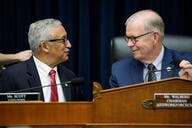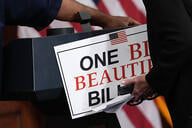You have /5 articles left.
Sign up for a free account or log in.
Public colleges and universities are just beginning to recover from the 2001 recession, and that progress is likely to be undone in the coming fiscal year, according to a new report.
The report, issued by the State Higher Education Executive Officers (SHEEO), indicates that per-student state appropriations were on the rise from 2006 to 2008, following four consecutive years of decline. Even with these gains, however, state-supported colleges are receiving less in constant dollars per student than they were in 2001 -- a peak year in data that stretch back to 1983.
The data do not show what happened to state support for the first half of the 2009 fiscal year, which began in July at most colleges. A survey of officials at SHEEO institutions, however, indicates that during that volatile period 65 percent of colleges took midyear budget cuts, and 44 percent are in states with governors who’ve proposed cuts or flat funding in the 2010 fiscal year.
If the impact of the 2001 recession is mirrored in the current economic downturn, higher education officials can expect lower state funding and increasing enrollments. At the same time, students and their families will probably see increased tuition rates that still fall short of addressing funding gaps, the report notes.
Paul Lingenfelter, president of SHEEO, said history shows that “it’s pretty clear how bad things might get -- even though we don’t have hard data yet.” History could be reversed, however, if higher education were made a priority in the federal stimulus bill currently being debated in Congress, Lingenfelter said.
“What it would do is it would enable the recovery that we’re on right now not to get derailed,” he said.
Recent changes to the Senate version of the bill, however, have excised billions of dollars that were to have gone to colleges, putting its legislation in conflict with a competing version in the House of Representatives, which would provide significantly more to states for aid to higher education. Lawmakers from both chambers, with the involvement of the Obama administration, have already begun what are likely to be contentious deliberations aimed at crafting a compromise.
Tuition Climbing Steadily
College enrollments, which increased by 25 percent between 1998 and 2008, show no signs of slowing down. Likewise, tuition is continuing to increase, as evidenced by a 20 percent uptick in net tuition revenues over the same period. Given these factors -- and a 7 percent decline in state support over 10 years -- it’s little surprise that students and their families are carrying an ever-greater share of the cost burden in college. Indeed, net tuition made up 36 percent of total education revenues in public higher education in 2008, up about 12 percentage points from 1983, the SHEEO report notes.
As the economic picture grows bleaker, several governors have suggested new or continued tuition freezes, bucking the historic trend of higher tuition in lean times. While history indicates tuition will go up over all, Lingenfelter said he’s not surprised some state leaders are trying to hold it down. (In some cases, though, as in Missouri, plans to hold tuition down depend on federal stimulus funds.)
“I think those kind of promises are understandable, because it’s very clear that the country has lost patience with the growth of [tuition in] higher education,” he said. “There is going to be a lot of pressure on keeping tuition down.”
Three Years of Recovery
| Year |
Appropriations per FTE student (constant $) |
1 Year % Change |
| 2001 | $7,819 | n/a |
| 2002 | $7,544 | -4% |
| 2003 | $6,994 | -8% |
| 2004 | $6,533 | -6% |
| 2005 | $6,438 | -1% |
| 2006 | $6,760 | +5% |
| 2007 | $7,003 | +4% |
| 2008 | $7,044 | +1% |
Largest Percentage Gains in Appropriations per FTE (2007-8)
| West Virginia | +24.5% |
| North Dakota | +13.8% |
| Louisiana | +13.4% |
| Montana | +11.7% |
| Utah | +10.3% |
Largest Percentage Losses in Appropriations per FTE (2007-8)
| Vermont | -11.2% |
| Rhode Island | -9.6% |
| Texas | -7.0% |
| Virginia | -4.2% |
| Florida | -4.1% |




